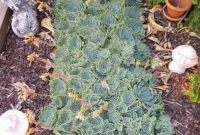Sedum rupestre ‘Angelina,’ commonly known as ‘Angelina’ stonecrop, is a perennial plant with succulent leaves that retains its greenery year-round. It forms a dense, low-growing mat, making it an ideal ground cover. The name “stonecrop” originates from Middle English and refers to the plant’s adaptability to rocky and gravelly environments.
 The ‘Angelina’ cultivar of S. rupestre boasts vibrant chartreuse or golden needle-like foliage, which intensifies based on the amount of sunlight it receives. Throughout the summer, it produces small yellow flowers that add a delightful touch to its appearance. As autumn arrives, the foliage undergoes a captivating transformation, transitioning to shades of orange or rust.
The ‘Angelina’ cultivar of S. rupestre boasts vibrant chartreuse or golden needle-like foliage, which intensifies based on the amount of sunlight it receives. Throughout the summer, it produces small yellow flowers that add a delightful touch to its appearance. As autumn arrives, the foliage undergoes a captivating transformation, transitioning to shades of orange or rust.
While ‘Angelina’ is commonly planted in spring, it is a resilient plant that can be grown almost any time of the year. It exhibits a moderately fast growth rate, though it may take one to two years before it starts flowering. Once established, this hardy plant thrives with minimal care and maintenance.
Whether used as a ground cover or in rock gardens, ‘Angelina’ stonecrop adds a vibrant and evergreen presence to outdoor spaces, enhancing their beauty and allure.
| Common Name | Angelina stonecrop, rocky stonecrop |
| Botanical Name | Sedum rupestre ‘Angelina’ |
| Family | Crassulaceae |
| Plant Type | Herbaceous perennial |
| Mature Size | 4–6 in. tall, 1–3 ft. wide |
| Sun Exposure | Full, partial |
| Soil Type | Moderately moist, well-draining |
| Soil pH | 6.0 to 7.0 (slightly acidic to neutral) |
| Bloom Time | Summer |
| Flower Color | Yellow |
| Hardiness Zones | 5a-9a (USDA) |
| Native Area | Europe, Turkey |
‘Angelina’ Stonecrop Care
 ‘Angelina’ stonecrop (Sedum rupestre ‘Angelina’) is a versatile and low-maintenance plant that thrives in sunny locations with well-drained soil. It is ideal for use as a ground cover, in perennial borders, rock gardens, or even in containers and hanging baskets.
‘Angelina’ stonecrop (Sedum rupestre ‘Angelina’) is a versatile and low-maintenance plant that thrives in sunny locations with well-drained soil. It is ideal for use as a ground cover, in perennial borders, rock gardens, or even in containers and hanging baskets.
With its resilient nature and stunning golden foliage, ‘Angelina’ stonecrop is a versatile and attractive addition to any garden. By providing adequate sunlight, well-drained soil, and minimal watering, you can enjoy its beauty and low-maintenance appeal.Here are some key care tips for ‘Angelina’ stonecrop:
Light
‘Angelina’ stonecrop prefers full sun for optimal growth and to enhance its vibrant golden foliage color. It can tolerate some shade but will exhibit the best coloration when grown in full sun.
Soil
This plant thrives in well-draining soil with a neutral pH. It is adaptable to sandy or gravelly soils that may not be highly fertile. The shallow roots can spread through small crevices, making it suitable for rocky terrain.
Water
‘Angelina’ stonecrop requires regular watering after planting to establish itself. However, it is drought-tolerant once fully established. Avoid planting it in heavy clay or waterlogged areas, as these can be detrimental to the plant’s health. Container-grown plants may need more frequent watering compared to those planted in the ground.
Temperature and Humidity
Angelina’ stonecrop is suitable for USDA zones 5a to 9a and exhibits good tolerance to both cold temperatures and high heat. It can withstand several degrees below freezing and bounce back well. As long as the soil has good drainage, it can handle high humidity levels.
Fertilizer
Generally, ‘Angelina’ stonecrop prefers lean soil and does not require fertilizer. Chemical fertilizers can cause the plant to stretch and become floppy. If the soil lacks nutrients, consider using compost instead.
Pruning
Pruning is typically done to manage size or remove faded blooms, leaving bare stalks. Use hand pruners to trim overgrown stems and remove any dead or diseased material. ‘Angelina’ stonecrop can be pruned at any time of the year, but it’s advisable to avoid extreme hot or cold temperatures.
Propagating ‘Angelina’ Stonecrop
‘Angelina’ stonecrop (Sedum rupestre ‘Angelina’) can be easily propagated through stem or leaf cuttings, as well as from seeds. This process allows you to create new plants and prevent overcrowding in the parent plant. Propagation can be done at any time during the growing season, but late spring or early summer is typically the best time. Here’s how to propagate ‘Angelina’ stonecrop:
- Prepare the necessary tools, including sterilized pruning snips or scissors, a pot, and a well-draining potting mix.
- Select a healthy stem measuring around two to five inches in length. Using the sterilized snips or scissors, cut the stem. Remove any leaves from the nodes below the soil line. Plant the cut end of the stem about an inch deep into a moistened, well-draining potting mix, filling the surrounding area with soil.
- Place the potted cutting in an area with indirect light while waiting for it to root.

- Keep the soil consistently moist during the rooting period, which typically takes about two to three weeks. To maintain high moisture levels, you can cover the pot with clear plastic wrap. Ensure some air circulation by removing the plastic cover for an hour each day. Replace the plastic cover afterward until the cutting roots.
- To check if the cutting has rooted, gently tug on the stem. If you feel resistance, it indicates that roots have formed. At this point, you can remove the plastic cover and transplant the rooted cutting into a larger pot or into an outdoor location. If the cutting has not rooted yet after six weeks, take another healthy cutting and repeat the process, ensuring the soil remains consistently moist throughout the rooting period.
By following these propagation steps, you can successfully multiply your ‘Angelina’ stonecrop and enjoy an abundance of these beautiful plants.
How to Grow ‘Angelina’ Stonecrop From Seeds
Growing ‘Angelina’ stonecrop from seeds is an exciting way to propagate this plant. Here’s a step-by-step guide on how to do it:
- Begin about four to six weeks before the last expected spring frost date or direct sow outdoors in early spring after the last frost.
- Prepare a seed-starting pot or tray with drainage holes and moisten the seed-starting mix.
- Firmly tamp down the soil in the container using your hands.

- Spread the ‘Angelina’ stonecrop seeds about an inch apart on the soil surface. Press each seed gently into the soil, ensuring good contact.
- Lightly cover the seeds with a thin layer of soil, scattering it over the top. Mist the surface with water using a spray bottle, and then cover the pot or tray with clear plastic wrap.
- Place the seeds in a warm location with bright, indirect light, maintaining a temperature of 65 to 72 degrees Fahrenheit (18 to 22 degrees Celsius). Another option is to position the seed trays or pots under fluorescent grow lights for 16 hours a day. Germination usually occurs within two to four weeks.
- Once seedlings emerge, remove the plastic cover. Keep the soil consistently moist and provide the seedlings with bright light. If using artificial light, keep the seedlings about six inches away from the light source and maintain a 16-hour light cycle.
- After several weeks of new growth, transplant the seedlings into larger pots. Only move them outdoors once all risk of frost has passed, ensuring they are acclimated to outdoor conditions gradually.
By following these steps, you can successfully grow ‘Angelina’ stonecrop from seeds and enjoy the beauty of this resilient plant in your garden or containers.
Potting and Repotting ‘Angelina’ Stonecrop
Potting and repotting ‘Angelina’ stonecrop (Sedum rupestre ‘Angelina’) in containers require specific care and attention. Here are some guidelines to follow:
Container Care: When growing ‘Angelina’ stonecrop in a container, it requires more maintenance compared to garden-grown stonecrop. Spring is the ideal time to consider repotting the plant when it has outgrown its current pot and appears rootbound. Note that stonecrop trailing out of the container does not necessarily mean it is too small for the pot. If desired, you can trim or prune the trailing stems to maintain a neater appearance.
Repotting Process: To determine if the plant is rootbound, gently lift the plant and examine the root system. If you observe an abundance of roots surrounding and overwhelming the soil, it’s time for a larger pot. When repotting, select a pot that is approximately one to two inches larger in size. Ensure the new pot has proper drainage holes. ‘Angelina’ stonecrop has shallow roots, allowing for flexibility in pot size and shape. Shallow bowl planters can also be suitable options.
Soil and Pot Selection: Use high-quality, well-draining soil when potting ‘Angelina’ stonecrop. The plant can thrive in various pot sizes, as long as adequate drainage is provided. Opt for a well-draining soil mix specifically formulated for succulents or cacti.
By following these guidelines, you can successfully pot and repot ‘Angelina’ stonecrop in containers, allowing the plant to thrive and showcase its vibrant beauty in your indoor or outdoor spaces.
Overwintering
Most sedums, including ‘Angelina,’ are cold-hardy and can withstand winter temperatures. During winter, the foliage may die back, and it is recommended to remove the dead growth to maintain the plant’s appearance and health.
Pot Placement: If ‘Angelina’ stonecrop is in a pot, it’s advisable to position it in a sheltered area, such as next to a building or amidst a grouping of other pots. This placement helps to protect the plant from harsh winter winds. However, it’s essential to avoid directly sunny spots, as sudden warm winter days can cause thawing, followed by freezing temperatures. Repeated thaw and refreeze cycles can be damaging to the plant’s root system.
Snow or Ice Cover: Pots that are covered by snow or ice tend to fare better during winter. The natural insulation provided by snow or ice helps protect the plant from extreme temperatures. However, if you frequently experience severe cold snaps that go well below the plant’s hardiness zone, additional measures may be necessary.
Extra Protection: To provide extra protection in extremely cold climates, consider surrounding the pots with thick burlap or even planting them directly in the ground. These measures can help the plants better withstand harsh winter conditions. When spring arrives and the ground thaws, it’s easy to dig up the pots and return them to their desired location.
Common Pests
‘Angelina’ stonecrop (Sedum rupestre) is generally resistant to pests and diseases, making it low-maintenance. However, slugs, snails, and scale insects can occasionally cause issues. Use organic baits or traps for slugs and snails, and treat scale with insecticidal soap or neem oil. Thankfully, ‘Angelina’ stonecrop is deer and rabbit resistant. Regular inspection and proactive pest management will help keep the plant healthy and beautiful.
How to Get ‘Angelina Stonecrop’ to Bloom
To encourage blooming in ‘Angelina’ stonecrop (Sedum rupestre), follow these guidelines:
‘Blooming in mid-summer, the yellow, star-shaped flowers of ‘Angelina’ stonecrop are attractive to various pollinators. Although most sedums have a subtle sweet fragrance, ‘Angelina’ stonecrop typically requires a few years to reach maturity and begin flowering reliably each year.

In early spring, promote healthy new growth and flowering by pruning any remaining dead stalks or branches. Use sharp and sterilized pruning shears to ensure clean cuts. This practice stimulates the plant’s growth and encourages blooming.
Ensure that your mature stonecrop plant receives adequate sunlight. Stonecrops rarely bloom in shaded areas. Additionally, avoid overwatering, as excessively moist soil conditions can hinder blooming. Most stonecrop plants require well-draining soil.
After the flowers of ‘Angelina’ stonecrop have faded, prune the flower stalks by cutting them down to the base of their stems. This not only cleans up the plant’s appearance but may also stimulate another round of flowers, provided that the growing conditions are favorable.
By following these tips, you can enhance the blooming potential of ‘Angelina’ stonecrop and enjoy its beautiful display of flowers alongside the wildlife it attracts.
Common Problems With ‘Angelina’ Stonecrop
‘Angelina’ stonecrop (Sedum rupestre) is a resilient plant that is generally resistant to diseases and pests. However, certain issues can arise if the environmental conditions are not suitable. Here are some common problems and their solutions:
Discoloration of Stems, Dropping Leaves: The appearance of discoloration and small white, red, or brown bumps at the soil line may indicate crown rot, caused by soil fungi. This disease is more common in outdoor garden settings with high humidity. Fungicides can help control the issue, but it’s best to remove and dispose of the diseased plant if it poses a risk to nearby plants.
Dead Spots on Leaves: Botrytis mold or leaf blotch, a fungus, can cause dead spots on leaves and may lead to flower death. This problem occurs after periods of high humidity and warm conditions. Remove any dead or diseased leaves or stems using sterilized pruning snips. If the entire plant is affected, it’s recommended to remove and discard it.
Stems Becoming Leggy: If your ‘Angelina’ stonecrop appears leggy, ensure it is receiving sufficient sunlight. Stems may stretch out in search of more light. Gradually move the plant to a slightly sunnier location if it is currently too shady. Avoid placing it in full sun immediately, as this can damage leaves not acclimated to intense sunlight.
If lighting conditions are adequate, trimming the leggy plants is a recommended solution. Pruning can also serve as an opportunity to collect stem cuttings and propagate new plants. Typically, pruning stimulates the plant to bush out at the cut site, creating a more compact and attractive appearance.
By addressing these common problems and providing suitable growing conditions, you can help maintain the health and vigor of your ‘Angelina’ stonecrop plants.




